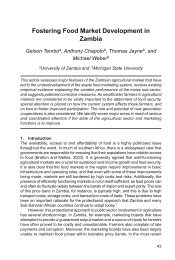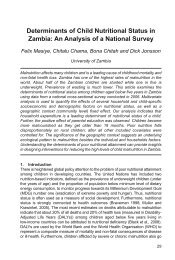Introduction to Basic Legal Citation - access-to-law home
Introduction to Basic Legal Citation - access-to-law home
Introduction to Basic Legal Citation - access-to-law home
Create successful ePaper yourself
Turn your PDF publications into a flip-book with our unique Google optimized e-Paper software.
In this context, plaintiffs and amici argue that when such patients are treated in emergency<br />
settings, the hospitals are not permitted <strong>to</strong> release them without a discharge plan for necessary<br />
continuing health care services, citing Public Health Law § 2803 (1) (g). Because they cannot<br />
be readily discharged, many remain in hospital facilities. Those who are discharged<br />
experience a cycle of emergency, recovery, stabilization, deterioration and the onset of<br />
another emergency. All of this, plaintiffs and amici contend, could be avoided through<br />
ongoing medical treatment.<br />
. . . .<br />
N.Y. Ct. App. R. Pract. § 500.1(g),<br />
http://www.courts.state.ny.us/ctapps/500rules10.htm#500_1.<br />
. . . .<br />
(g) <strong>Citation</strong> form. Where New York authorities are cited in any submissions, New York<br />
Official Law Report citations shall be included, if available.<br />
Note: The format of citations in the published opinions of the New York courts is the subject<br />
of a detailed manual of the New York State Law Reporting Bureau, the New York Official<br />
Reports Style Manual (2012), http://www.courts.state.ny.us/reporter/Styman_Menu.htm.<br />
North Carolina: Supreme Court citation practice | <strong>Citation</strong> rule(s)<br />
| ><br />
Contents | Index | Help | <<br />
Examples from Craig v. County of Chatham, 356 N.C. 40, 565 S.E.2d 172 (2002)<br />
. . . .<br />
The enactment and operation of a general, statewide <strong>law</strong> does not necessarily prevent a county<br />
from regulating in the same field. However, preemption issues arise when it is shown that the<br />
legislature intended <strong>to</strong> implement statewide regulation in the area, <strong>to</strong> the exclusion of local<br />
regulation. See N.C.G.S. § 160A-174(b) (5) (2001). "'Municipal by-<strong>law</strong>s and ordinances must<br />
be in harmony with the general <strong>law</strong>s of the State, and whenever they come in conflict with the<br />
general <strong>law</strong>s, the by-<strong>law</strong>s and ordinances must give way.'" State v. Williams, 283 N.C. 550,<br />
552, 196 S.E.2d 756, 757 (1973) (quoting Town of Washing<strong>to</strong>n v. Hammond, 76 N.C. 33, 36.<br />
(1877)). The <strong>law</strong> of preemption is grounded in the need <strong>to</strong> avoid dual regulation. See, e.g.,<br />
283 N.C. at 554, 196 S.E.2d at 759.<br />
. . . .<br />
Turning now <strong>to</strong> the Health Board Rules enacted by the Chatham County Board of Health, we<br />
note that they contain more stringent rules than those established in the EMC regulations.<br />
However, N.C.G.S. § 130A-39 specifically grants local boards of health the power <strong>to</strong> enact<br />
213




